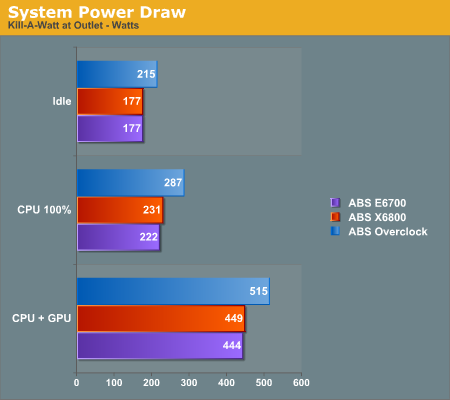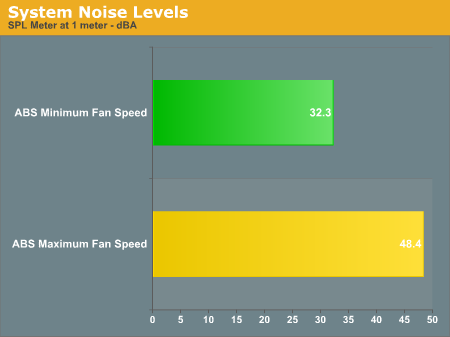ABS Ultimate X9: Core 2 Extreme Hits a Speed Bump
by Jarred Walton on August 18, 2006 1:35 PM EST- Posted in
- Systems
Noise and Power
We've looked at how the system performs, but another aspect of performance that needs to be addressed is the noise and power requirements. We tested the ABS system at stock, overclocked, and underclocked speeds in both idle and 100% load situations. We then measured power draw and noise levels created by the system. 100% CPU load was achieved by running two instances of Folding@Home along with the Splinter Cell: Chaos Theory benchmark. Performing video encoding or other CPU intensive tasks while playing a game will achieve a similar CPU load. We also provided a CPU-only stress test to show the difference between 100% CPU load and 100% CPU + GPU load. The CPU load was achieved by running the two Folding@Home instances without starting any games or other tasks.
Noise results basically showed no difference between any of the clock speeds, as all of the fans run at a constant RPM. However, the water cooling fan does come with the ability to control fan speed, so we set that to minimum for idle testing and maximum speed to show the difference in noise levels.


It should come as little surprise that increasing the CPU speed requires more power. However, the system is designed such that noise levels are relatively constant. This is certainly not a silent system, but neither is it terribly loud, even at maximum fan speed. At minimum fan speed, the system does become nearly silent, which is particularly impressive when you consider the amount of noise normally generated by two X1900 cards. If your typical use of the system will not place it under heavy stress, you can use the fan speed control to dramatically lower the noise levels. We would recommend cranking up the fan speed for gaming sessions, however, as the GPUs and CPU will definitely put out a lot of heat. Besides, with all the noise from your speakers, the importance of reducing fan noise is greatly diminished.
The power results are interesting, as they show both the efficiency of the Core 2 CPU as well as the inefficiency of the X1900 GPUs. Going from 100% CPU load to 100% CPU + GPU nearly doubles the total system power draw. In other words, the two GPUs consume as much power together as all the remaining components. Needless to say, even at the heavily overclocked setting, power requirements are still lower than your typical NetBurst system, but we're now waiting for energy efficient GPU designs to go along with the lower power Core architecture.
Another interesting aspect of the power requirements for the Core 2 Extreme is that EIST (Enhanced Intel SpeedStep Technology) was able to function even at overclocked settings. The default CPU speed is 11 x 266, or 2.93 GHz. EIST allows the CPU to run at a 6X multiplier, resulting in a clock speed of 1.6 GHz. At the overclocked settings, the CPU runs at 3.5 to GHz under load, but drops to 1.92 GHz when idle. Now even overclockers can take advantage of energy-saving technologies. In case you were wondering, the idle power results for the "E6700" and X6800 are identical because the CPU throttled down to 1.60 GHz in both cases.
We've looked at how the system performs, but another aspect of performance that needs to be addressed is the noise and power requirements. We tested the ABS system at stock, overclocked, and underclocked speeds in both idle and 100% load situations. We then measured power draw and noise levels created by the system. 100% CPU load was achieved by running two instances of Folding@Home along with the Splinter Cell: Chaos Theory benchmark. Performing video encoding or other CPU intensive tasks while playing a game will achieve a similar CPU load. We also provided a CPU-only stress test to show the difference between 100% CPU load and 100% CPU + GPU load. The CPU load was achieved by running the two Folding@Home instances without starting any games or other tasks.
Noise results basically showed no difference between any of the clock speeds, as all of the fans run at a constant RPM. However, the water cooling fan does come with the ability to control fan speed, so we set that to minimum for idle testing and maximum speed to show the difference in noise levels.


The power results are interesting, as they show both the efficiency of the Core 2 CPU as well as the inefficiency of the X1900 GPUs. Going from 100% CPU load to 100% CPU + GPU nearly doubles the total system power draw. In other words, the two GPUs consume as much power together as all the remaining components. Needless to say, even at the heavily overclocked setting, power requirements are still lower than your typical NetBurst system, but we're now waiting for energy efficient GPU designs to go along with the lower power Core architecture.
Another interesting aspect of the power requirements for the Core 2 Extreme is that EIST (Enhanced Intel SpeedStep Technology) was able to function even at overclocked settings. The default CPU speed is 11 x 266, or 2.93 GHz. EIST allows the CPU to run at a 6X multiplier, resulting in a clock speed of 1.6 GHz. At the overclocked settings, the CPU runs at 3.5 to GHz under load, but drops to 1.92 GHz when idle. Now even overclockers can take advantage of energy-saving technologies. In case you were wondering, the idle power results for the "E6700" and X6800 are identical because the CPU throttled down to 1.60 GHz in both cases.










48 Comments
View All Comments
JarredWalton - Saturday, August 19, 2006 - link
Don't use the (bracket) H (closebracket) abbreviation in our comments - that's the code for highlight enable, which makes your text white. LOL
JarredWalton - Saturday, August 19, 2006 - link
Multiple uses cause even more troble. :p
JarredWalton - Saturday, August 19, 2006 - link
Have I shut off all text highlights yet? Enquiring minds want to know!
JarredWalton - Friday, August 18, 2006 - link
Take a look at similarly configured Alienware, Falcon NW, VoodooPC, etc. systems and see what they cost. $4500 for the ABS is an absolute bargain by comparison. And don't think that all of those systems are going to be more stable than this ABS. I tried a Quad SLI config for a while that was much, MUCH less stable than this system. The review would have been very unfavorable, but as the company basically pulled the configuration I had there was no reason to "review" a phantom product.Alienware is about $4300 without overclocking or watercooling.
FNW Talon with E6700 and 7950GX2: $6000
FNW Mach V with X6800 watercooling and CrossFire: $8230
VoodooPC Omen CrossFire: $7600
None of those come factory overclocked as far as I can tell, but I'm sure they could be. Still, there's a big difference between $4500 and $6000+. Are they more stable? I don't know - I haven't tested any of the above configurations.
As for ways to improve system reviews, I'm open for suggestions. Simply stating "be like HardOCP" doesn't really help much. What would you like to see added? Compare what this review told you about gaming to what others show, and let me know what's really different about the conclusions. Where do we fall short? I have plenty more system reviews, so if there are specific improvements to be made I'd love to try and make them.
Thanks,
Jarred Walton
Editor
AnandTech.com
yyrkoon - Friday, August 18, 2006 - link
Personally, I find your articles fine the way they are, whihc is why I'll read YOUR articles over Toms any day of the week (because you guys seem to tell it how it is, and how you'd think the company you're reviewing would want to hear it.yyrkoon - Friday, August 18, 2006 - link
err and NOT how you'd think the company you're reviewing would want to hear it (left out 'not'), sorry.MarkHark - Friday, August 18, 2006 - link
Thumbs up for you, Jarred, twice in fact!First for a well-thought, well-written review, second and most important for your last comment.
samuraiBX - Friday, August 18, 2006 - link
now if one of you will please run over me so I can get the money from my insurance... :PJarredWalton - Friday, August 18, 2006 - link
We've got a $1400 system review coming soon, for "the rest" of our readers. :)yyrkoon - Friday, August 18, 2006 - link
Sub 1,000 system review would be much bettter ;) Anyhow, nice clean looking wiring (until you look into the drive bays), additional fan on a water cooled CPU ?! 3000-4000 Price ?!Personally, I would never consider buying a OEM type system, but man even though it has semi clean wiring, neat gadgets like a Air cooling assisted water block, excellent non gaming performance, I would expect said system to be stable, offer the best gaming performance period, and to cook for me . . .